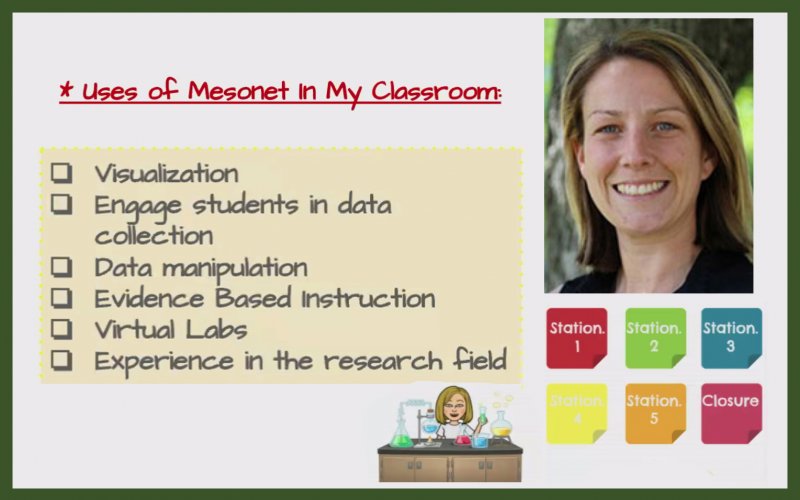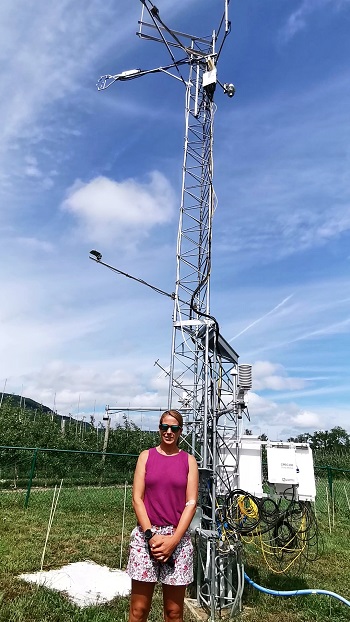Local Earth Science Teacher Brings NYS Mesonet Data to the Classroom

ALBANY, N.Y. (July 1, 2021) – Data from the nation’s most advanced and largest early warning detection network is making New Yorkers more weather resilient, while also helping shape the minds of the next generation of scientists.
Crystal Perno, an earth and physical science teacher at Acadia Middle School in Shenendehowa Central School District, is partnering with the New York State Mesonet at UAlbany to build a series of educational tools that can be used by K-12 teachers statewide to incorporate the network’s weather data into their classrooms.
She’s part of the Questar III BOCES STEM Research Institute (SRI), modeled after a successful Columbia University science teacher professional development program. The SRI provides an opportunity for secondary school teachers of science, mathematics, engineering or technology to work for two summers under the mentorship of researchers or industry professionals, related to the content they teach. As a result, teachers develop new curricula based on their experiences.
Perno has worked remotely with June Wang, a research associate professor in the Department of Atmospheric and Environmental Sciences and the NYS Mesonet quality assurance manager and education & outreach director. Perno started last summer and was renewed for a second summer in 2022 due to limitations caused by the COVID-19 pandemic.
“The NYS Mesonet education outreach program is an integral part of our mission,” Wang said. “We’ve been successful in offering student tours of the Mesonet Operations Center and local network sites, but the overarching goal is to go beyond the ‘show and tell’ aspect and bring our weather data into classrooms. Crystal is doing a fantastic job in helping us get there.”
Backyard Weather Science

The NYS Mesonet is comprised of 126 standard weather stations spaced within 20 miles of each other, including at least one in every county and borough. Each site offers continuous updates of localized weather variables, such as current temperature, wind speed and direction, precipitation, humidity, snow depth and soil moisture. New data is available every five minutes with real-time camera images.
Last summer, Perno embarked on her own research project to get more familiar with the network, compiling soil temperature data at Mesonet’s Ithaca, Millbrook and Geneva sites. She used that experience to create templates for four lesson plans.
Perno piloted the lesson plans in her classroom earlier this year, asking students to compare and contrast current soil properties as well as other weather variables at Mesonet sites throughout the state. The real-world application of the project was met with tremendous success, according to Perno. Other earth science teachers at her school have since incorporated the lesson plans into their classrooms.
“Sharing this weather data with my students has been great learning tool,” Perno said. “I’m now able to give them a real problem to solve, like figuring out which locations in New York have the best soil conditions to grow a garden. It engages them in a way that a textbook or presentation never could.”
An Expanding Curriculum
Outside of her school district, Perno just completed a three-part virtual workshop through the New York State Master Teacher Program, a network of more than 800 public school teachers, where she shared her own Mesonet experiences and welcomed feedback from attendees on how it can best be used in their classrooms.
She also helped to write a grant proposal for the Institute of Education Sciences, in collaboration with Wang and Alan Oliveira of the School of Education, to create a web-based application called “Backyard Weather Science” that is designed to support integrated STEM teaching and learning.
“Overall, I feel that my teaching has been taken to the next level,” Perno said. “Working with June and the Mesonet team has given me an invaluable experience that I’m now able to take and explain to my students. I can tell them I’ve worked in the research field and give them an inside look at what it is like to be a scientist.”
Perno plans to return in person next summer at the new $180 million ETEC building, which is slated to open this fall. It will house all of UAlbany’s Climate-Weather Enterprise.




